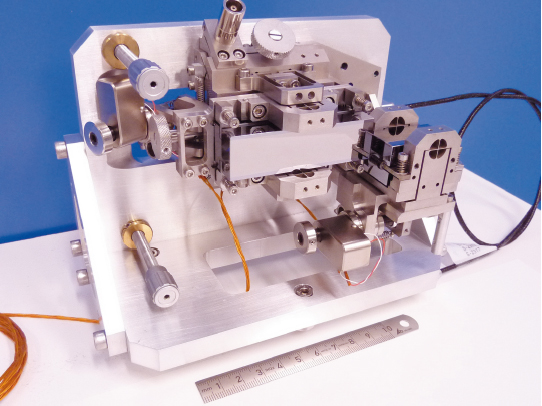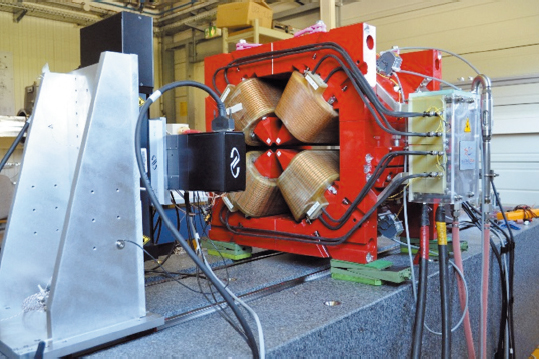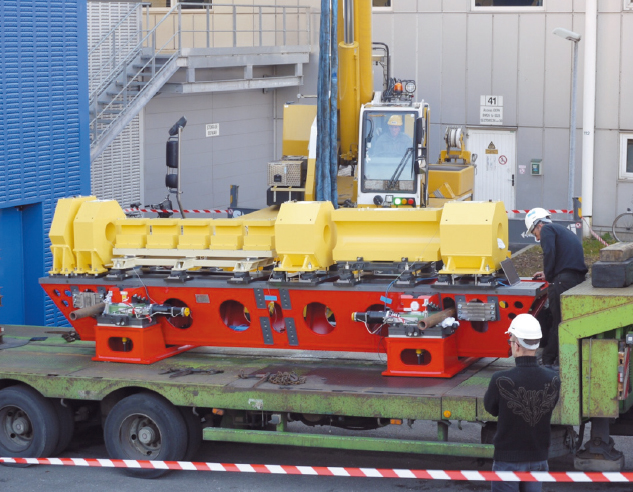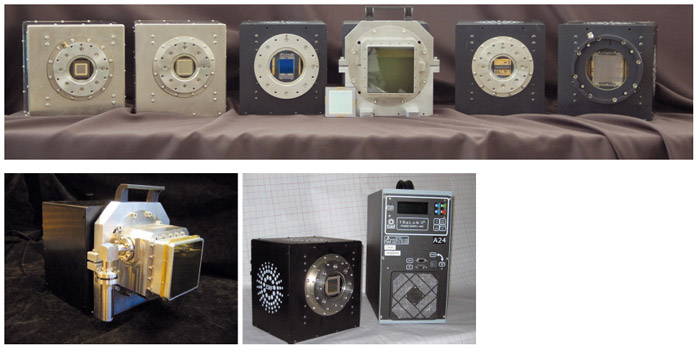- Home
- Users & Science
- Scientific Documentation
- ESRF Highlights
- ESRF Highlights 2015
- Status of the Upgrade Programme
Status of the Upgrade Programme
2015 has been a challenging year for the ESRF with ongoing user operation, the final year of Phase I of the Upgrade Programme and the first year of the ESRF-EBS project. We are proud to report that the staff in all ESRF divisions has mastered this challenge and achieved tremendous progress for the facility and its users. In the following, we have summarised a selection of the major activities that took place at the ESRF in 2015.
The upgrade of the beamline portfolio with 19 new or fully refurbished beamlines has been completed in 2015. The key performance indicators have all been reached and most beamlines are back in full user operation. The following list provides a summary on the upgrades of the beamline portfolio implemented in Phase I of the Upgrade Programme.
ID01 – X-ray nano diffraction:
Beamline ID01 has been reconstructed in 2014 and returned to partial user operation in early 2015. The last remaining items were installed by the end of 2015 and commissioning of these shall be finished by mid 2016.
ID02 – X-ray ultra-small and small angle scattering:
The time-resolved ultra-small angle scattering beamline ID02 returned to user operation in July 2014. The key performance indicators have been reached and a large number of successful academic and industrial user experiments have been carried out already.
ID06 – Hard X-ray Microscopy prototype:
The development of the Hard X-ray Microscope (HXRM) continues and will be finished in spring 2016. The design of the challenging high precision positioning unit for the optics and sample is nearly completed.
ID09 – Time-resolved X-ray diffraction and scattering:
The time-resolved scattering beamline ID09 has undergone a gradual upgrade without a shutdown since 2010. The key elements such as the high speed chopper have been installed and the new large area detector received. The mirror as the last remaining element will be installed in spring 2016.
ID10 – X-ray photo correlation spectroscopy and X-ray scattering from liquid surfaces:
The reconstructed beamline ID10 has been in routine user operation since 2012 after having reached all key performance indicators. The last remaining item, the new diffractometer for liquid samples, was installed during the winter shutdown.
ID15 – High energy X-ray diffraction and scattering:
The last large-scale project within Phase I started with the decommissioning of beamlines ID15A and ID15B in December 2014. The new hutch complex with its infrastructure has been constructed. The design and procurement of beamline components is progressing. The beamline should receive first users in autumn 2016.
ID16 – X-ray nano-imaging and nano-analysis:
The ID16A – nano-imaging beamline has resumed user operation (Figure 1). Cryo-cooling for the sample stage was ready for installation at the end of 2015. The ID16B – nano-analysis beamline is operational with XANES spectroscopy and in situ holo-tomography, including a furnace reaching 800°C.
 |
|
Fig. 1: Nanofocusing KB system for beamline ID16A. |
ID17 – Paleontology project at the medical beamline:
The paleontology project at beamline ID17 has been successfully finished with the installation of a dedicated microtomography station.
ID19 – High energy X-ray imaging:
The beam expander has been installed in the summer shutdown 2015 and is currently under commissioning. The upgrade of the beamline was completed with the delivery of three new detectors for fast and ultrafast imaging down to the time scale of a single X-ray pulse.
ID20 – X-ray resonant and non-resonant inelastic scattering:
The inelastic scattering beamline ID20 resumed full user operation. The installation of the phase plate setup for polarisation control will be finished in spring 2016.
ID22 – X-ray powder diffraction:
ID22 is in full user operation with a new transfocator and a new Perkin Elmer flat panel large area detector. The delivery of the new high resolution diffractometer has been delayed. The installation is now planned in spring 2016.
ID24 – Time-resolved and extreme conditions X-ray absorption spectroscopy:
The two XAS beamlines ID24 and BM23 returned to user operation in 2012 and 2013, respectively. The chemistry programme at ID24 has resumed operation after commissioning of the infrared spectrometer.
ID30 – MASSIF – Macromolecular crystallography and scattering:
The complex of structural biology beamlines BM29, ID30A-1, ID30A-3 and ID30B has been completed in 2015 and is in full user operation. ID30A-1 is the only fully-automated hands-off user beamline worldwide. A new prototype versatile sample changer is in operation on ID30B together with a high capacity dewar.
ID31 – High energy X-ray diffraction and scattering:
Beamline commissioning with the HEMD instrument has started and first user experiments were performed at the end of 2015. The remaining optical elements and part of the experimental hutch facilities will be installed in 2016 (see Figure 2).
 |
|
Fig. 2: ID31 experimental hutch during construction of the beamline. |
ID32 – Soft X-ray dichroism and resonant inelastic scattering:
The soft X-ray spectroscopy beamline ID32 features two branches. The XMCD branch has returned to user operation. The RIXS branch has received first users employing medium resolution. The final version of the sample cooling stage and the high resolution grating have been installed.
During 2015, several upgrades to parts of the accelerator system were completed within Phase I of the Upgrade Programme. The radio frequency (RF) system has been renewed with the addition of solid state amplifiers and HOM-damped cavities. All the planned straight sections have been lengthened from 5 m to 6 m, with one 7 m-long section in cell 23, enabling the installation of the RF cavities. Following the construction of ID32, a new helical undulator was put into place in its straight section in 2015. Canted straight sections have also been installed at ID15, ID16 and ID30. An improved electron beam position monitoring system and a fast orbit feedback system have been successfully developed and installed. The new bunch cleaning system in the booster will greatly aid top-up operation, scheduled for 2016.
Last year also marked the beginning of the execution phase of the EBS project. A fruitful year followed, in which 90% of the design work was completed and calls for tender were sent out for all of the magnets as well as the stainless steel and aluminium vacuum chambers. Significant effort was put into optimising the design of the ESRF–EBS lattice. While evolution of the standard cell is now minor, work has progressed on the design of the injection section, on chromaticity tuning and on the optimisation of lifetime and injection efficiency. Different solutions for the sources for the bending magnet beamlines have been studied. The requirements for a back-up solution in case of a magnet power supply failure have been specified. The study of collective effects is also progressing with a first longitudinal impedance budget. Bunch lengthening and Touschek lifetime estimates have been correspondingly updated. The benefits of a third-harmonic RF cavity have also been explored.
More than one thousand magnets will be built for and installed in the ESRF-EBS storage ring. Large-scale procurement has started and the first two contracts were signed at the end of 2015. The dipole magnet assembly zone is being prepared in the Chartreuse Hall including benches for full magnetic characterisation (Figure 3).
 |
|
Fig. 3: High gradient, 87 T/m quadrupole magnet under test on a magnetic measurement bench. |
The prototype girder for the new machine has been put through a series of motion tests (Figure 4) to check the alignment of the attached dummy magnets. It could be concluded that the magnets move less than 50 micrometres out of place during transportation, thus ensuring that the girders for the EBS project can be completely pre-assembled before transportation into the storage ring.
 |
|
Fig. 4: Transportation of the prototype girder during stability testing. |
The RF system design for the new storage ring has also been finalised. Two of the existing three klystron transmitters will be kept to power (with redundancy) 10 HOM-damped single-cell cavities in cells 5 and 7 of the new ring. Three existing 150 kW solid state amplifiers will be moved to cell 25 where they will power one cavity each. Optionally, a fourteenth cavity will be fed by the in-house-developed solid state amplifier. The procurement is making good progress with twelve single-cell HOM-damped cavities in fabrication and almost all other major RF components having been ordered if not yet delivered.
In 2015, resources had to be carefully balanced in order to finalise the Upgrade Phase I beamline projects, keep pace with the tight schedule for the ongoing upgrade of the accelerator complex, and initiate the ESRF-EBS programme, without neglecting to provide efficient operational support for the functioning accelerator complex and experimental facilities. Project management played a key role and our project management practices will be consolidated by modernising tools and methods, and by fostering the dissemination of best practices to all project managers. This will include a regularly updated, multi-annual resource schedule.
Strategic developments for future scientific instrumentation as presented in the Orange Book have been initiated. The first objective is the development of new instrumentation, which will be crucial in exploiting the new source properties to the full extent; the second objective is the consolidation of major ongoing instrumentation programmes initiated during Upgrade Phase I. In the context of ESRF-EBS, four main development lines centered around beamline control and data management, X-ray detectors (Figure 5), X-ray optics, and high-precision engineering have been identified.
 |
|
Fig. 5: ESRF-built imaging cameras - more than 25 are in operation at the beamlines. |
In line with the worldwide trend towards an open data policy to enhance the dissemination of knowledge, the ESRF has developed a data policy which was presented and discussed by SAC and approved by Council in December 2015. A data manager was recruited and the metadata capture on several beamlines has started. As part of the data analysis strategy, work progressed on a new data analysis platform, comprising common software routines for analysing synchrotron data, a set of generic applications and a catalogue of software. This work is supported with advances in the implementation of identity management to allow for the persistent authentication of users, major extensions to our disk storage and tape archive systems, and investigations of the usage of cloud technologies. A task force has been set up to coordinate the efforts required to implement the open data policy, with the aim of its full implementation for all beamlines by mid 2020.
The creation of a Precision, Dynamics and Mechatronics Unit in spring 2015 will strengthen our expertise in real-time instrument control and provide the basis for the development of mechatronics concepts, combining mechanical design with on-line metrology and fast-feedback closed-loop control.
The Crystal Analyser Laboratory (CAL), dedicated to the development and production of curved crystal analysers for spectroscopy applications, was officially inaugurated at the occasion of the autumn SAC meeting. The facility has so far produced more than 70 analysers for instruments at the ESRF and other facilities in Europe and the United States.
The development of a generic double crystal monochromator (DCM) for X-ray spectroscopy with ultra-high stability is progressing well. Design studies for the rotation axis and the crystal cage were concluded, and a prototype version of these components will be built and tested in 2016.
The ESRF strategy also relies on international collaboration to foster synergies with many other European research infrastructures. As part of the European Union’s research and innovation programme, Horizon 2020, the ESRF is involved in several major projects that were launched in autumn 2015.
R. Dimper, M. Krisch, P. Raimondi, H. Reichert and J. Susini



